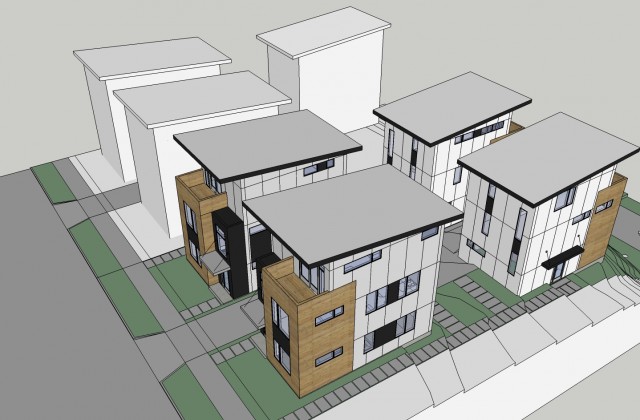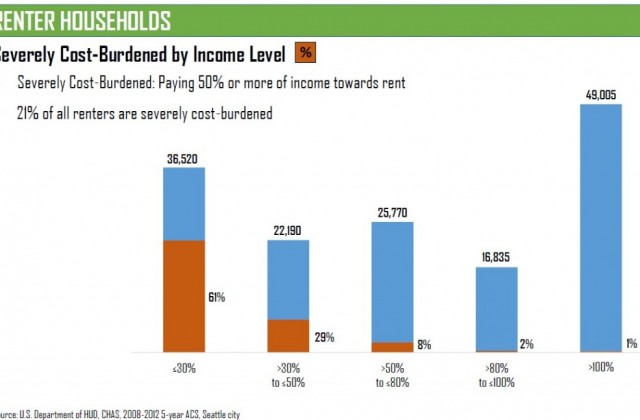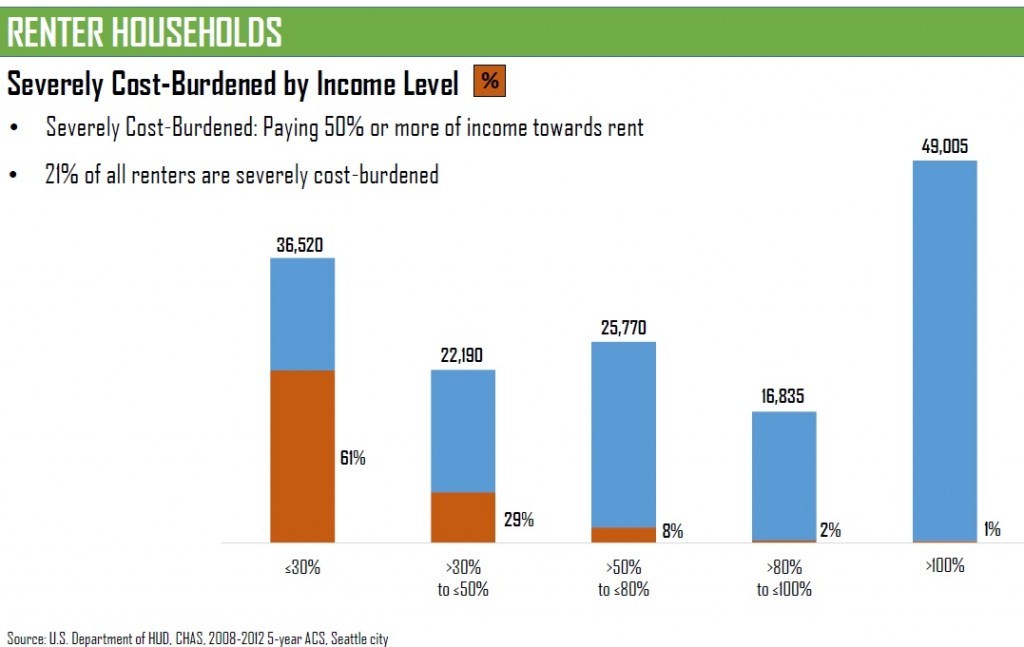Lot Suit: Local Builder Challenges City Rule that Increases Housing Prices
‘Abutting lot’ requirement illegal under state law
Imagine if your neighbor didn’t bother to sort their recycling from their compost but you got charged a fine – even though you followed the rules.
That wouldn’t be fair, but that’s similar to what the City Council did last year when it passed legislation that created a strange new requirement that certain new housing developments must go through the City’s onerous design review process because of development happening on land next door; the two projects would exceed the 8 unit threshold requiring full design review. New and much needed housing will face unjustified delays and costs or not get built at all.
One housing project is in exactly this spot with the new requirement, meaning another year in a costly design review process to build the 4 town homes in Delridge or building just two homes to stay out of design review. Instead, the builder is taking on City Hall and filing a legal challenge to the new requirement.
The Complaint, filed yesterday in King County Superior Court, argues that the City’s process is unlawful because it imposes the lengthy and expensive design review process on one person’s lot because of what is happening on another person’s lot. This violates RCW 82.02.020 because the regulatory burden is not “reasonably necessary as a direct result of the proposed development.”
The complaint also asserts that the City’s new rule is “a taking of property without compensation in violation of Article I, section 16 of the Washington State Constitution and the doctrine of unconstitutional conditions;” and that the rule violates due process because it does not achieve a legitimate public purpose.
Instead of 4 town homes priced at around $500,000 there could end up being two larger ones that will cost double that or about $1,000,000. That certainly doesn’t help the affordability problem the City claims it is trying to solve.
The new rule is unfair, illegal, and increases housing prices by reducing density and supply and adding more costs. The City Council can and should solve the problem by repealing the code as soon as possible. Councilmember Bruce Harrell offered an amendment last year to remove this recommendation from legislation but the Council voted that amendment down 7 to 2. Smart Growth Seattle has requested Councilmember Rob Johnson propose and work to pass a repeal of this rule.
Housing Data: We Can Solve Problems AND Feel Better Too
Think about any problem you might have in your own household or at work. Usually that problem comes with two kinds of measures, quantitative and qualitative. For example, if you’re running low on milk you know what “low” means when you pick up the carton and if feels lighter than usual. That’s a qualitative measure. You know how much to buy, 12, 16, or 20 ounces, based on your experience with how much milk your family use in a week. That’s your quantitative measure. One is a feeling and the other one is a number. What bedevils our discussion of housing in Seattle is the continual muddling of these two kinds of measurements by City officials, advocates, and the press are leading to bad policy. There is recent an example from Councilmember Lisa Herbold that’s worth pointing out.
In a blog post on the City Council’s blog, Herbold trots out some figures we’ve seen before. The conversation she facilitated about existing affordable housing is described as
Wide-ranging, but the problem can be neatly summed up in three slides. First, here’s the distribution of Seattle’s renters across income levels, and the number who are “severely cost burdened” meaning 50% or more of their income is going toward rent:
The breathless conclusion is:
- There is almost no housing that is affordable for the 36,000 households making 30% of annual median income (AMI) or less.
- Almost all the “workforce housing,” the housing affordable for those making 50-80% of AMI, is older housing.
Shocking! Slap your forehead! The truth is that the charts don’t say much more than poor people have trouble paying for housing. Is it really a shock to learn that a person who earns 30 percent of Area Median Income (AMI) $19,000 a year has trouble paying for housing? Of course a person earning such a low income is going to pay an enormous percentage of their income on housing – and on everything else. They are poor! They likely pay a larger share of their income for everything from food to transportation to health care if they even have it.
The perpetually left leaning Council led by Herbold always talks about this as a housing problem when it simply isn’t – it’s a poverty problem.
Let’s look at the problem in another way. I have a friend who just had a new baby in February. Here’s what one article says she can expect to pay for diapers:
Parents can count on spending close to $50 per week ($2,448 per year) on diapers, formula and baby food alone. Then toss in such big-ticket items as furniture, equipment, clothes, childcare if you’re returning to work, medical expenses, and well, you get the idea.
For someone earning $19,000 per year, before taxes, that’s roughly 7 percent of their income not to mention, as the article does, all the other expenses. So can we expect Councilmember Herbold to lead a crusade against diaper companies demanding more affordable diapers? Will we tax diapers to somehow reduce their price? Diaper Linkage Taxes? Mandatory Inclusionary Diapers? Of course not. That would a waste of energy because we recognize that many existing anti-poverty and job training programs are trying to reduce costs for poor people and provide them with opportunities to increase their wages.
On the upside, the discussion reported in the blog post seemed to be headed in a better direction than most (i.e. how can we tax and fee “greedy developers” to solve the housing “crisis”), focusing on how to help use existing tools to preserve older, cheaper, market rate units.
The obvious thing from the charts—especially the first one—is that the “cost burden” goes down as income increases. We also know that housing prices fall when production keeps up with demand for housing. We also know more jobs means better wages. We also know that as we add more, higher priced, new housing to the market, people with more money take those units, reducing price pressures on older housing.
The solution to the housing “crisis” is to do everything we can to welcome growth from economic development and new jobs: that helps wages. We should also reduce barriers to housing production created by overregulation and costs from fees, taxes, and fines on new housing. More new, market rate housing means a more favorable ratio of dollars to housing units, reducing inflation in the housing market. And in cases where families are so poor that they simply can’t buy any housing at all, we use public finance and taxation to fairly and evenly raise revenue—including from the development and operation of new and existing housing development—for smart programs like vouchers to ameliorate the housing cost burden on our city’s poorest family.
Unfortunately, City leadership does the opposite, blaming housing production for a housing crisis, creating feel-good penalties for developers, and mixing measures about how expensive housing feels (affordability expressed as a ratio of income to housing cost) rather than investing in broad programs that increase the number and variety of jobs in our economy, reducing limits to production of housing, creating smart voucher programs, and building subsidized housing for only the poorest of poor and homeless families. The smart solution would make us feel better and actually solve the problem. That would be an accomplishment.
OK, Housing is a Right; Don’t we Still Need More?
So if housing is a right, not a commodity to be bought and sold the question still remains: don’t we need more.
I’m not being snide here at all. What I am asking is, if we have 1000 people who need homes and 100 homes then whether housing is a commodity or a right, don’t we still need to build at least 900 more units of housing? What I find mystifying is why advocates of housing as a right seem to always demand that price controls and other mandates be imposed instead of more production.
Can’t we all agree we need more housing of all types, in all neighborhoods and corners of Seattle that is affordable to all levels of income? Isn’t that true whether housing is a right or a commodity?
Krugman on Housing and Regulation
I’m pointing to the New York Times again today. Paul Krugman, who is generally seen to be the leading economist of the left, wrote a column making a not so liberal point — or at least a point that I make all the time over and against the dominant lefty paradigm in Seattle — overregulation makes housing more expensive:
Living in the city isn’t like living on the beach, because the shortage of urban dwellings is mainly artificial. Our big cities, even New York, could comfortably hold quite a few more families than they do. The reason they don’t is that rules and regulations block construction. Limits on building height, in particular, prevent us from making more use of the most efficient public transit system yet invented – the elevator.
Now, I’m not calling for an end to urban zoning. Cities are rife with spillovers, positive and negative. My tall building may cut off your sunlight; on the other hand, it may help sustain the density needed to support local stores, or for that matter a whole city’s economic base. There’s no reason to believe that completely unregulated building would get the balance right.
But building policies in our major cities, especially on the coasts, are almost surely too restrictive. And that restrictiveness brings major economic costs. At a national level, workers are on average moving, not to regions that offer higher wages, but to low-wage areas that also have cheap housing. That makes America as a whole poorer than it would be if workers moved freely to their most productive locations, with some estimates of the lost income running as high as 10 percent (emphasis mine).
It’s a solid article and balances out Tim Egan’s bad performance in the pages of the same paper. And Krugman has made similar points before, agreeing in that when it comes to high housing prices,
Land-use restrictions are the most likely culprit. Yes, this is an issue on which you don’t have to be a conservative to believe that we have too much regulation.
And it isn’t a libertarian idea either to suggest that less is more when it comes to housing regulation. The need to use the eraser end of the pencil isn’t a radical idea: it just makes common sense. And as I have started regularly pointing out, even if housing were an entitlement and government provided a certain amount of it for no cost for anyone who wanted it, we would still need to build lots more housing. It always helps to have Paul Krugman on our side to help make this point.
Dude, Where’s My Journalism
Locally based writer for the New York Times Tom Egan trotted out a bunch hackneyed terms and phrases about growth in an article titled “Dude, Where’s My City?” It left me asking Egan, “Dude, where’s your editor?” Here’s a paragraph that was among the worst:
Rising rents threaten to push out the quirky and creative types who make these places eternally young and resilient. You saw the pattern in Brooklyn — that urban tipping point. An average wage earner living in Brooklyn would somehow have to spend 120 percent of his or her monthly income to make rent.
There’s that word: quirky. Egan also uses “funky” too to describe the tragic and horrible impacts of a growing city. I’ve seen these phrases over and over again — Egan’s article would have been fine as conversation over coffee or as a tweet, but whining about how growth is changing our city is hardly worth hundreds of words. I even searched for the term “quirky” and “growth” and found dozens of paragraphs like this from Columbus, Ohio that make Egan look like he just rewrote someone else’s screed:
Yet what is alarming for many long-time residents is that these “luxury apartments” and the complexes they come with could shred the souls of several unique and quirky Columbus neighborhoods.
There it is, more or less the same sentiment expressed in cities facing the change that comes with growth. It’s old. It’s been said. Where’s the insight? Egan offers none.
In stark contrast a composer from San Francisco, Aaron Gervais, wrote a brilliant and useful discussion about the changes that come with growth. His question is more about how growth and change impacts artists, but it is written with a depth of knowledge and offers a unique perspective: growth can be good for artists and the “quirky.”
Even formerly unredeemable neighborhoods of Oakland have started to succumb to baby strollers, designer boutiques, and rising rents. All the while, artists and the poor get pushed out, and any last remnant of cultural life goes along with them. Or so the story goes.
In reality, gentrification has an artistic upside, even when you factor in all that bad stuff. Gentrification is not just about the disneyfication of formerly quirky neighborhoods at the expense of anything unique or original. Yes, some dumbing down does occur, but that’s only part of it.
Gervais goes on to describe the changes in the Filmore neighborhood in San Francisco from the it’s early days as Japantown through the war and into the current day. His point is one I’ve made about neighborhoods like South Park, which went from a rural area with mostly Italian farmers to a gritty industrial neighborhood with a significant Latino population. Was that change bad? Maybe in some ways and for some people, but it wasn’t a change that was engineered or favored one group over another. It just happened that way.
Gervais wisely points out that,
Regardless of how things ultimately play out, the Tech Bros have arrived, and they have to live somewhere. So they can either live in monocultural suburbs, where life is insular and devoid of contrasting worldviews, where they will vote conservatively and deprive the arts of support. Or they can live in cities, where life is much more pluralistic and full of contrasting viewpoints, where they will vote more progressively and take part in the arts. Given that choice, I’ll take what’s behind Door #2.
Me too, whether what’s behind it is quirky or not.






